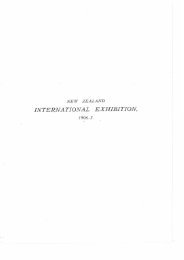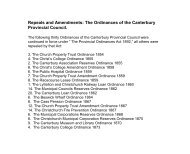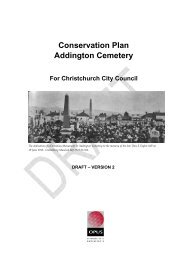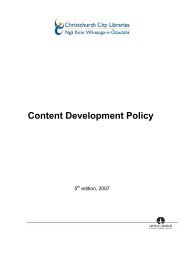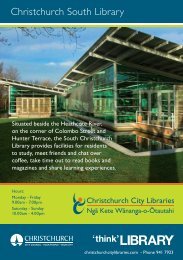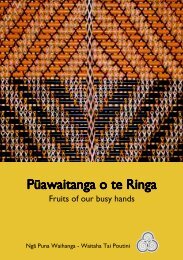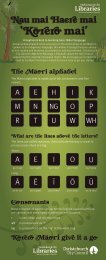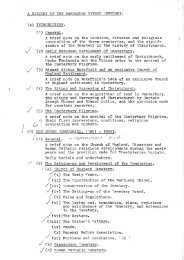Rich man, poor man, environmentalist, thief - Christchurch City ...
Rich man, poor man, environmentalist, thief - Christchurch City ...
Rich man, poor man, environmentalist, thief - Christchurch City ...
You also want an ePaper? Increase the reach of your titles
YUMPU automatically turns print PDFs into web optimized ePapers that Google loves.
48<br />
effecting a ‘wonderful transformation’ and converting the river<br />
once more into ‘an easily negotiated water highway’. Within<br />
a few years, motor boats would be journeying up and down<br />
the river and launch excursions to Banks Peninsula would<br />
become popular. However, a new bridge with a low clearance<br />
would ‘throttle the entrance to the river…’<br />
Avon Member of Parliament D G Sullivan assured the local<br />
authority that for <strong>Rich</strong>ard to triumph would be a ‘miracle’.<br />
Councillors claimed that the idea of the ‘river as a waterway<br />
had gone to the dogs’ and that <strong>Rich</strong>ard held to ‘the wild dream<br />
of visionaries’. Counsel for the ‘River Banker’, A F Wright,<br />
put the case so well that it was accepted by Mr Justice Stringer.<br />
Then, even as a personal dispute broke out between New<br />
Brighton’s mayor and counsel, A W Owles and J A Flesher,<br />
the Court of Appeal adjudicated in favour of the local body.<br />
The impressive dissenting decision of Mr Justice McGregor,<br />
however, proved sufficient to persuade <strong>Rich</strong>ard to take the<br />
fight to the Privy Council.<br />
The case did not reach the Law Lords. <strong>Christchurch</strong> Mayor,<br />
J K Archer, seeking to have <strong>Rich</strong>ard given the substance of<br />
what he asked, was told by recalcitrant beach dwellers that<br />
‘Mr. Owen had been able to get the city council at his beck<br />
and call’. Two Cabinet ministers mediated, one being Reform<br />
Party luminary, Sir Francis Dillon Bell. Even then councillor<br />
and carrier E L Smith stated, ‘I am going to have this matter<br />
held up for as long as I can’.<br />
New Brighton diehards hoped for a more sympathetic<br />
Minister of Marine after the 1928 election. A new government<br />
and minister did, indeed, come to power but, more<br />
importantly, the 1929 local body elections produced seaside<br />
councillors who wished to compromise. A bridge with a six<br />
foot six inch clearance was built, New Brighton being excused<br />
from having to contribute towards the increased height of<br />
the structure. Alas, those who gave <strong>Rich</strong>ard moral support<br />
were reluctant to contribute substantially towards the legal<br />
bills. Moreover, boats have not come sailing with the tide,<br />
the noticeable climb to the top of the bridge being all that<br />
remains to remind one of the great battle. A disgruntled New<br />
Brighton councillor commented, ‘More people went over the<br />
bridge in two hours than went under it in a year’. He has<br />
been proved substantially correct.<br />
The ‘River Banker’ knew failure. In 1929 he stated that<br />
riverside reserves were needed ‘as a lung right in the heart of<br />
our busy city’, that the old fire brigade station in Chester<br />
Street (now Oxford Terrace East) should be demolished and<br />
the land returned to the public domain. Although in failing<br />
health, Charles Chilton wrote to J K Archer opposing this<br />
view. A deputation including <strong>Rich</strong>ard, Ell, civic benefactor T<br />
J Edmonds and E J Howard MP attended a council meeting<br />
and found that Archer wanted the Plunket Society to use the<br />
building. The Mayor stated that no conservation scheme was<br />
as significant as the work of the society; indeed, ‘it was possible<br />
to overdo the question of reserves until it became a mere fad’.<br />
Archer’s view prevailed.<br />
There were other setbacks. <strong>Rich</strong>ard had an artist, James<br />
FitzGerald, paint pictures of the proposed Kerrs Reach regatta<br />
course. In the artist’s impression, the banks were neatly<br />
grassed, boulevard drives ran along either side of the river<br />
and four boats, each containing eight occupants, were<br />
travelling upstream. The tailor attended city council meetings<br />
with his paintings fixed to blackboards but was told that his<br />
schemes were too futuristic to be considered.<br />
In the 1940s, the idea of a regatta on the Avon was revived.<br />
The channel was diverted and a long straight course made<br />
ready for rowing contests which were to be part of the 1950<br />
<strong>Christchurch</strong> Centennial Games. The old bend in the river –<br />
whose Maori name ‘Wainoni’ Professor A W Bickerton had<br />
taken for his property – became but a backwater snaking<br />
around the modern Porritt Park. <strong>Rich</strong>ard did not live to see<br />
the partial success of his plan for Burwood and Dallington.<br />
<strong>Rich</strong>ard’s relationships with other public men were often<br />
acrimonious. Certainly H T J Thacker hoped that ‘once<br />
having got a taste of the boulevard atmosphere’, the citizens<br />
would carry the roadway down to the sea on both sides of



